#3 day inca trail hike
Explore tagged Tumblr posts
Text
3 Day Inca Trail Hike: An Unforgettable Adventure with Alpaca Expeditions

If you’re looking for a memorable adventure in Peru, the 3 Day Inca Trail Hike is the perfect way to experience the ancient wonders of the Inca civilization. This iconic trek takes you through breathtaking landscapes, from lush forests to rugged mountains, and culminates in the awe-inspiring Machu Picchu. We provide this incredible hiking experience, ensuring a seamless journey with expert guides, well-planned itineraries, and top-quality gear. The 3 Day Inca Trail Hike offers a challenging yet rewarding experience, where you'll walk in the footsteps of the Incas and witness stunning views that are truly once-in-a-lifetime. Along the way, you'll visit ancient ruins, learn about the rich history of the region, and enjoy the camaraderie of fellow hikers. With us providing this unforgettable adventure, you can trust that your journey will be safe, comfortable, and extraordinary. Whether you're an experienced hiker or a beginner, the 3 Day Inca Trail Hike is an adventure you won't want to miss, with us ensuring that every step is an unforgettable experience.
For more Information
Visit us: www.alpacaexpeditions.com
Mobile No : (+51) 84 254278
E Mail Id : [email protected]
#2 day inca trail tour#2 day inca trail vs 4 day#2 day inca trail with camping#2 day short inca trail#2 day vs 4 day inca trail#2 week peru itinerary with inca trail#3 day 2 night inca trail#3 day inca trail#3 day inca trail hike
0 notes
Text
I got back from Peru this morning after an overnight flight from Lima. :) It's been wonderful to be with Derek and Westin again, and to nap and relax after a 10-day trip!
Unorganized thoughts,
The Inca Trail was the most intense, demanding physical experience of my life. The group my friend and I were with hiked 26 miles/41 kilometers over 4 days, in rough terrain including the highlands of the Andes, the Amazon, and the cloud forests of Peru. The hike was at altitude, at an elevation nearing 13,828 feet/4,215 meters - which I struggled with, coming from living at sea level. I learned that I'm fit on sea level, but NOT at altitude. I also caught a pretty bad cold from another group member overnight on Day 3, which made Day 3 and Day 4's hikes extra challenging.
We were up at 4:30 AM every morning (3:30 AM on our final day to reach Machu Picchu), and due to my slower pace/altitude struggles, I usually had ~10-12 hours of hiking steep inclines and inclines. It was really so hard and I had to be very careful on the steep, rocky steps. The hiking poles saved me! We had to ascend and descend four mountains over the course of our hike. Ascents were really challenging for me due to shortness of breath at altitude. Descents were easier on my cardiovascular system, but required a lot of concentration to make sure I didn't miss my footing and fall down steep, uneven stone steps. Each step was about 12 to 18 inches high, which is significant for my friend and I, who are under five feet tall.
We also camped every night for 3 nights, in tents, which I've never done before. Our group bonded over the struggles of surviving the hideous campsite bathrooms, not being able to shower for four days, finding safe and private places to use the bathroom in the wild, staying warm at night, staying dry in the constant rain on day 2, and our feet and legs killing us at the end of the day. We ate every breakfast, lunch, dinner, and teatime together, and I liked everyone in the group. :) We enjoyed our time together and talked a lot.
We got to explore several Inca ruins on the way to Machu Picchu, and Machu Picchu itself was incredible. The scenery and views along the hike - the mountains, the jungle, the cloud forest - made it worth it, despite how physically difficult it was. I've never seen anything like it before. The sound of the birds singing in the jungle, the llamas and alpacas in the mountains, the butterflies, the rainforest flora... That was amazing.
One of my favorite memories was Thursday morning, when we all woke up at 3:30 AM and hiked in the dark to be among the first at the checkpoint to enter. We all brushed our teeth in the forest around the trail and hung out until the sun rose at 5:30 AM and we could enter the park. :)
My friend and I spent Friday chilling out in Cusco and recovering from our hike. We were SO tired when we got back to our hotel on Thursday night, and so relieved to finally shower and sleep in a real bed. We traveled from Cusco to Lima to Atlanta/Miami to Minneapolis. I got home this morning around 10:45 and I've literally just been sitting on the sofa or napping. Doing post-trip laundry was the big accomplishment of the day, lmao.
This was such an adventure. I'm so glad I could do it, and return safe. It was wonderful to experience South America for the first time, and I hope to go back many times. It was wonderful to completely disconnect with no phone/internet while I was in the mountains. The whole experience was a test of my physical and mental endurance, and my ability to be out of my comfort zone - but as I told my friend when we got back, while I was on the trail, simply focusing on nature and getting through each ascent and descent safely, it let me forget about the things I've experienced this year. My dad dying, estrangement from my mom, the ongoing interpersonal stresses at work. It was a great way to close out my 30th year, which has also been my hardest year.
My 31st birthday is tomorrow. :)
33 notes
·
View notes
Photo


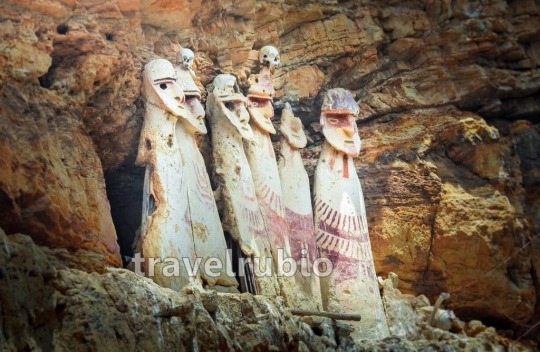

Découvrez les meilleurs Voyages au Pérou 2025-2090. Voyages au Pérou 15 jours en famille #machupicchu . #sejoursrubio
Pérou Bolivie en petit groupe. plus de 344 visites avec TRAVELRUBIO
https://sejoursrubio.com
Quelle est la meilleure heure pour visiter le Machu Picchu et éviter les pièges?
Le meilleur moment de la journée pour visiter le Machu Picchu est tôt le matin, de préférence au lever du soleil. Quel meilleur circuit Machu Picchu ?
Nouveau circuit touristique au Machu Picchu Circuit classique court.
C'est le circuit le plus recommandé et le plus complet à l'intérieur du Machu Picchu (pour cette raison, l'achat de ce billet doit être effectué en ligne 3 ou 4 mois à l'avance).
Ce billet n'offre pas de trekking supplémentaire dans les montagnes du Machu Picchu. Où prendre la photo Machu Picchu ? 9 endroits pour prendre les meilleures photos à Machu Picchu 9 endroits pour prendre les meilleures photos à Machu Picchu L'entrée du Chemin de l'Inca. ... Les lamas de Machu Picchu. ... La cité Inka de Machu Picchu. ... Le sommet de la montagne Huayna Picchu. ... Les escaliers incas du Huayna Picchu. ... La cité inca depuis Machu Picchu. ... Les constructions incas à Machu Picchu.
Quand acheter billet Machu Picchu ?
Le nombre de places est limité et ces tickets sont souvent pris d'assaut, surtout en haute saison. Il est donc fortement conseillé de réserver au moins 2 mois à l'avance, toujours sur le site officiel du gouvernement.
Comment monter au Machu Picchu depuis Aguas Calientes ?
Pour aller à l'entrée du Machu Picchu depuis Aguas Calientes, vous avez deux possibilités : A pied : depuis le centre comptez 1h30 de marche avec 2 km jusqu'au pont puis 1 200 marches à monter. C'est sportif mais ça réveil ! En navette : les navettes partent du centre toutes les 10 min à partir de 5h30 jusqu'à 17h30.
Machu Picchu 2 jours et 1 nuit by train par sejoursrubio Tripadvisor
Machu Picchu 2 jours et 1 nuit by train par travelrubio Machu Picchu tour by car and by train 2 days combined Car and Train Expedition, showcasing the awe-inspiring beauty and rich history of this iconic Inca ...
Le Classic Inca Trail dure 4 jours, parcourt 39 kilomètres et se termine dans l'Intipunku (porte du Soleil) du Machu Picchu. Le Chemin Inca court ne dure que 2 jours, couvre 12 kilomètres et se termine également à Intipunku, au cœur de la cité inca de Machu Picchu. Il est donc préférable d'acheter ses billets à l'avance, surtout en saison haute.
Quel prix pour visiter le Machu Picchu ?
Visiter le Machu Picchu à moindre coût ! - #sejoursrubio How much does it cost to go to Machu Picchu? How much is the Machu Picchu entrance? The ticket for adults costs 159.00 Peruvian soles (US$52.00). How far in advance should I buy the Machu Picchu ticket entrance? During the peak season, better to buy it 2 months in advance, especially if you're planning to hike Huayna Picchu Mountain.
Quel est le meilleur circuit du Machu Picchu ?
Le circuit 2 est considéré comme le meilleur de Machupicchu puisqu'il permet une visite plus complète des constructions de la citadelle inca. Inclut la photo classique ! Ofertamos vuelos y tours por todo el mundo con #travelrubio
Conozca Machu Picchu en Promo, Colegios, Universidades, Empresas. Organisez votre séjour avec nous en mars, avril, mai, juin, juillet, août, septembre, octobre, novembre et decembre.
Salkantay trek 5 days - 4 nigths to Machu Picchu #sejoursrubio 🥑 Manger des avocats frais au Pérou 🌈 Mountain plus colorée se trouve au Pérou, Vinicunca 🍸 Boir du pisco sour au Pérou 🍽️ La gastronomie péruvienne est très bonne et ... 🚣 Lac Titicaca pour faire du kayak
🤣 Les péruviens sont gentils. 🏨 Dormir chez l'habitant au Pérou. https://sejoursrubio.com/dormir-chez-... 👣. https://sejoursrubio.com/faire-du-tre...
Pallay Punchu is known as the "new" Rainbow Mountain in Peru. Mineral-rich rocks form turquoise and maroon stripes in the rocky peaks, about three hours from Cusco. You can find a complete guide to visiting this jaw-dropping site at: •
SÉJOURS PÉROU BOLIVIE 15 jours en petit GROUPE. #sejoursrubio ...
Combine this all with a delicious cuisine and warm, welcoming locals, a trip through Peru & Bolivia will be completely unforgettable. / @travelrubio . https://sejoursrubio.com/hotels-heber... https://travelrubio.com/ / @sejoursrubiofr / alfredo.rubiosilva.7 / perou-en-petit-groupe-15-jours-avec-sejour...
PÉROU - BOLIVIE Du Machu Picchu à Uyuni.
Cette confortable odyssée relie le célèbre Machu Picchu à l'étourdissant Salar d’Uyuni. Nous découvrons les lieux les plus magiques et les plus beaux de cette magnifique région d’Amérique du Sud.
Lors d'un voyage au Pérou, plongez dans le riche patrimoine culturel du pays et vivez un moment inoubliable dans l'empire des Incas.
Machu Picchu. ... Géoglyphes de Nazca. ... Oasis de Huacachina. ... Vinicunca (Montagne Arc-en-ciel) ... Îles Ballestas et Paracas. ... Vallée d'Urubamba. ... Sacsayhuamán.
#machu picchu en train full day#Machu Picchu by car 2D 1N#Machu Picchu depuis Lima#La gastronomie peruvienne ceviche a Lima#Loger chez lhabitant a Puno Perou#Lac Titicaca Perou dormir chez lhabitant Uros#Pisco sour au Perou boison peruvienne 44 grades#Manger du cochon d inde ou lama au Perou#Voyages en famile Perou 15 jours#2 semaines au Perou en groupe
2 notes
·
View notes
Text
The Inca Trail - Parte Dos
Day 3 was only 6 miles but felt loooong as it incorporated over 3,000 steps downward. When we began, the clouds were laying between the mountains and rapidly moving. Just before lunch, we climbed up to the beautiful Inca site of Phuyupatamarca which aptly translates to "Village in the Clouds".

Again, we had a lovely 3 course lunch, adorned with animal food-based replicas. We took a brief tarp nap before continuing down. At one point, the rain began and we became poncho people. Luckily, the rain let up just in time for us to arrive at the Ruins of Intipata. Each Inca site we visited was increasingly more spectacular.
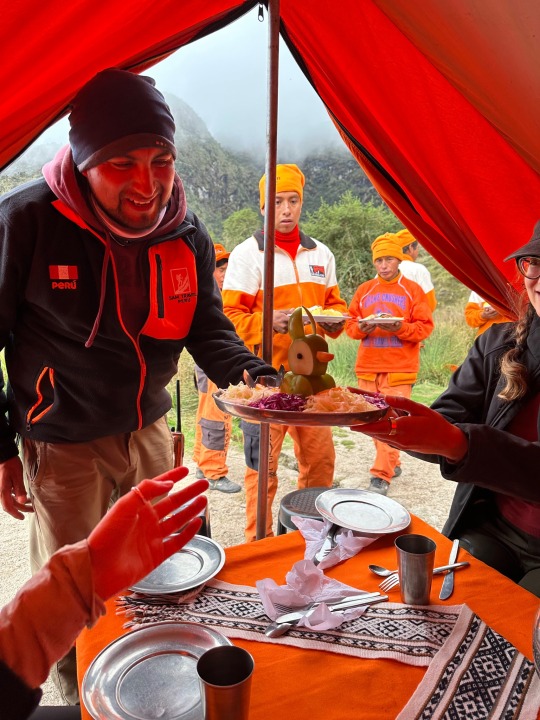
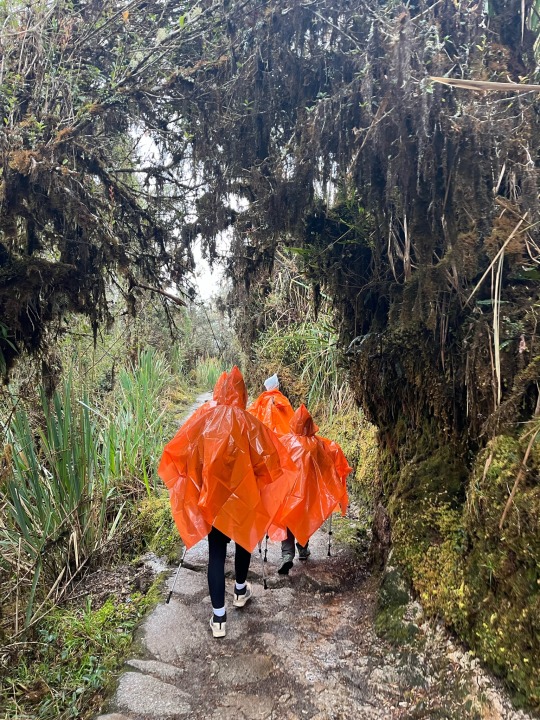

On our way from Intipata to our campsite we were greeted by a few trail llamas. At camp, the chef surprised us with a birthday cake he made on the trail for Vale! We had our last well-made camp dinner before the goodbye ceremony where we thanked and tipped our porters or "bebeees".
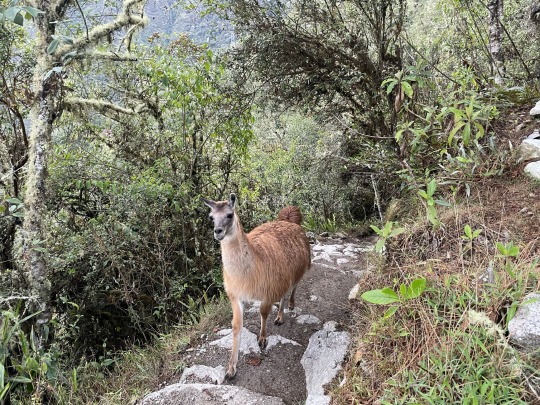
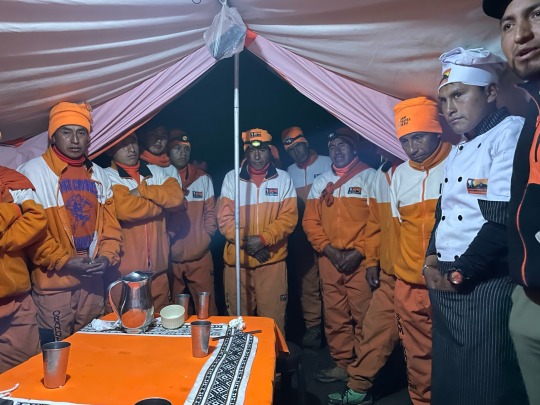
Before we knew it, the day we'd all been hiking for had arrived. We had a brutal 3 AM wakeup call so we could get to the checkpoint before the seats filled up. We actually got the last seats left and waited there until the trail opened at 5:30 AM. Luckily, we had some nice stars to observe as we waited.
We arrived at Inti Punku, or the Sun Gate, by 6:30 and caught our first glimpse of Machu Picchu!! Then, the photoshoots began. As we descended, we continued to get new and more spectacular views of the ruins.

After all the impressive Inca sites we saw along the trail, I expected Machu Picchu to be anti-climactic. It most certainly was not. The main questions that came to mind were how and why? Our guide talked us through a lot of the history but the truth is, most of it is quite a mystery. That makes the site even more special in my eyes.

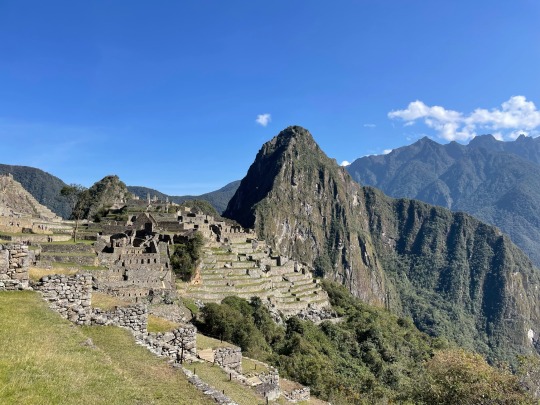
Bess, Josh, Junior, and I departed the group to begin our hike of Huayna Picchu Mountain which is on the list of the 20 most dangerous hikes in the world. With 1,000 ft of elevation gain in less than 1 mile, the hike was challenging but not impossible. It only took us about 45 minutes to reach the summit which had rewarding views of the Andes, Machu Picchu Mountain, and Machu Picchu itself.

On our way back, we walked through Machu Picchu again and were almost trampled by two crazy llamas! We thought, wouldn't it have been crazy to survive one of the worlds most dangerous hikes just to have been killed by llamas when we finished?
We ended the trip with a relaxing lunch in the scenic town of Aguas Calientes before venturing back to Cusco.
4 notes
·
View notes
Text
Places to Go for Vacation
Introduction
Planning a vacation is an exciting endeavor, and the world is brimming with remarkable destinations to explore. Whether you're seeking natural beauty, cultural richness, adventure, or relaxation, there's a perfect vacation spot for everyone. In this article, we'll take a tour of some of the top places to go for vacation, each offering a unique and unforgettable experience.
1. Bali, Indonesia
Known as the "Island of the Gods," Bali is a tropical paradise with stunning beaches, lush rainforests, and vibrant culture. Visitors can explore ancient temples, enjoy water sports, and savor Balinese cuisine. Don't miss the tranquil rice terraces and the energetic nightlife in Seminyak.
2. Santorini, Greece
Santorini, an enchanting island in the Aegean Sea, is famous for its iconic white-washed buildings, crystal-clear waters, and dramatic sunsets. It's a romantic destination with breathtaking views, ancient ruins, and delicious Mediterranean cuisine.
3. Kyoto, Japan
For a taste of Japanese culture and history, Kyoto is a must-visit. This city is renowned for its traditional tea houses, stunning cherry blossoms in spring, and beautiful temples. Stroll through bamboo forests, participate in tea ceremonies, and admire the art of the geisha.
4. Bora Bora, French Polynesia
Bora Bora is synonymous with paradise. Its turquoise lagoons, overwater bungalows, and coral reefs make it a dream destination for honeymooners and water enthusiasts. Snorkeling, scuba diving, and relaxation are the order of the day.
5. Tuscany, Italy
Tuscany's rolling hills, historic cities, and delectable cuisine make it a favorite European destination. Explore the charming streets of Florence, sample world-class wines in Chianti, and savor the simple pleasures of life in the Tuscan countryside.
6. Maldives
The Maldives, a collection of over a thousand coral islands, is a tropical haven with luxury resorts and stunning marine life. It's an ideal spot for beach lovers, honeymooners, and those seeking seclusion in paradise.
7. Machu Picchu, Peru
Machu Picchu, the ancient Inca citadel nestled in the Andes Mountains, is a UNESCO World Heritage site and one of the world's most iconic travel destinations. Hike the Inca Trail or take the train to witness this archaeological wonder.
8. New York City, USA
For the bustling urban experience, New York City is a top choice. Explore iconic landmarks like Times Square, Central Park, and the Statue of Liberty. The city offers a vibrant arts scene, diverse cuisine, and endless entertainment.
9. Cape Town, South Africa
Cape Town is a city of breathtaking beauty, nestled between Table Mountain and the Atlantic Ocean. Explore vibrant neighborhoods, visit the Cape of Good Hope, and savor South African wines in the surrounding vineyards.
10. Patagonia, Argentina and Chile
Patagonia offers awe-inspiring natural beauty with its glaciers, mountains, and remote wilderness. It's a dream destination for hikers, nature lovers, and wildlife enthusiasts.
11. Iceland
Iceland's dramatic landscapes include geysers, waterfalls, volcanoes, and geothermal springs. The Blue Lagoon, the Golden Circle, and the Northern Lights are just a few of the attractions that make Iceland a unique vacation destination.
12. Marrakech, Morocco
Marrakech is a bustling and exotic city in North Africa. Explore the bustling souks, visit the historic medina, and relax in stunning riads. Marrakech offers a blend of tradition and modernity.
13. Sydney, Australia
Sydney, with its iconic Opera House and Sydney Harbour Bridge, is a vibrant city with beautiful beaches, world-class dining, and a variety of cultural attractions. The city's coastal charm and natural beauty are hard to resist.
14. Rio de Janeiro, Brazil
Rio de Janeiro is known for its lively Carnival, stunning beaches, and iconic Christ the Redeemer statue. Enjoy samba music, relax on Copacabana Beach, and explore the lush Tijuca Forest.
15. Istanbul, Turkey
Istanbul straddles Europe and Asia, offering a rich blend of cultures, history, and architecture. Visit the Hagia Sophia, the Blue Mosque, and the Grand Bazaar for an unforgettable experience.
Conclusion
The world is a treasure trove of vacation destinations, each offering a unique blend of natural beauty, culture, history, and adventure. Whether you're drawn to tropical paradises, ancient cities, or remote wilderness, there's a place for every traveler to discover and savor. When planning your next vacation, consider the experiences that ignite your wanderlust and create memories that will last a lifetime.
3 notes
·
View notes
Text
Wow! We have done so much since my last post.
We left Cusco a few days ago on our way to Machu Picchu. We took the easy option by train and bus, whilst the others on our tour spent 3 days hiking on the Inca and Quarry trail ( it's an age thing ) Anyway more of that later.
We left Cusco for a detour and overnight stay to the sacred valley. Only 4 of us,but well worth the trip. We sampled the Peruvian corn beer, but don't get excited it is only 1.5% Vol ( I think top deck shandy has more alcohol than that ). At the bar we also found the Guinea pig store, all still alive. you just ,have to do is choose one, and they do the rest. Don't worry we didn't do it. However we did drive through, The Guinea Pig mile, where every restaurant sells Guinea Pig. We stopped at one, but just to confirm, before I cause any more offence, it was just for a photo opportunity.
Next day we travelled to ollantaytambo, for another overnighter, a really nice little place, where I had 1, 2 too many proper peruvian beers. The following day we ran up a load of ancient Inca steps, just for fun and a few more photos opportunities, before boarding the Inca Rail to Machu Picchu. I think it must have been 1st class, as we had traditional singers and dancers to see us onto the train,and then a performance of a traditional folk song, it was like a show at disney world. ( I will post the video later, for those who aren't bored enough already ) We stayed overnight in Machu Picchu town, full of backpackers, restaurants and gift shops along with the obligatory, hundreds of requests to either eat in restaurants or buy souvenirs. At least they understand 'No thanks'.
Early start next day on the bus to Machu Picchu itself. Thankfully the weather held for us and we were able to take classic pictures of the ruins, but with us in them.Absolutely amazing, just gob smacked to be there, and Ann had the obligatory emotional moment, before we took literally hundreds of photos. luckily the battery in my camera and phone lasted. I promise not to post them all.
Today we booked a trip to Rainbow Mountain with 4 others from the tour. I think they were a but worried we might not make it to the top, as its a steep walk of 1.5 hours from the car park to reach the 5000m summit ( Apparently the same height as Everest base camp, however our next trip will not be to Nepal ) We prepared with altitude sickness medication and resisted the opportunity to hire horses up to the top, more in pity that one of the unlucky nags would have to carry me. Great achievement and great photos.
Back at the hotel in Cusco now recovering from our ordeal. I think we may have a sleep before dinner.
Off to the peruvian amazon tomorrow in search of the legendary Yakumama.
Next post after our amazon adventure.
5 notes
·
View notes
Text
Essential Guide to Preparing for the Inca Trail to Machu Picchu
The Inca Trail to Machu Picchu is one of the most iconic treks in the world, offering an unforgettable journey through breathtaking landscapes, ancient ruins, and a deep sense of history. It’s a trek that combines adventure, cultural immersion, and stunning natural beauty, culminating at the awe-inspiring Machu Picchu. But before embarking on this incredible adventure, it's essential to prepare thoroughly to ensure a safe, enjoyable, and memorable experience.
In this guide, we’ll walk you through everything you need to know to prepare for the Inca Trail to Machu Picchu, from physical conditioning and gear requirements to permits and acclimatization tips.
1. Physical Preparation: Get in Shape
The Inca Trail is a challenging hike that spans approximately 43 kilometers (26 miles) and takes 4 days to complete. While the trek doesn’t require technical climbing skills, it demands physical fitness, stamina, and mental resilience. Here’s how to prepare:
Start Early
Begin training at least two to three months before your trip. Focus on building endurance and strength, as you'll be hiking at high altitudes and navigating steep and uneven terrain.
Focus on Cardiovascular Fitness
Incorporate activities like hiking, running, cycling, or swimming into your routine to build cardiovascular endurance. Aim for at least 30 minutes of aerobic exercise, 4-5 times a week.
Hike with a Backpack
Training with a loaded backpack (around 5-10 kg) will simulate the weight you’ll carry during the trek and help you build strength and stamina.
Strengthen Your Legs
The Inca Trail is known for its steep ascents and descents. Strengthening your legs through squats, lunges, and calf raises will help you handle the challenges of the terrain.
Practice on Uneven Terrain
If possible, train on hills, rocky paths, or uneven surfaces to prepare your body for the rugged trail.
Flexibility and Mobility
Include stretching or yoga in your routine to improve flexibility, reduce the risk of injury, and enhance your balance and mobility on the trail.
2. Acclimatization: Prepare for High Altitude
The Inca Trail reaches an altitude of 4,200 meters (13,780 feet) at its highest point, Dead Woman’s Pass. Proper acclimatization is crucial to avoid altitude sickness and ensure you can enjoy the trek to the fullest.
Arrive Early
Most trekkers fly into Cusco, which sits at 3,400 meters (11,150 feet). Arriving a few days before your trek allows you to adjust to the altitude. Use this time to relax, hydrate, and avoid strenuous activities.
Stay Hydrated
Dehydration can exacerbate the symptoms of altitude sickness. Drink plenty of water, and avoid alcohol and caffeine, as they can contribute to dehydration.
Avoid Overexertion
Take it easy in the first few days to give your body time to adjust. Avoid rushing through your activities, and don’t push yourself too hard.
Consider Medication
Some trekkers take Diamox (acetazolamide) to help with acclimatization. Consult your doctor before your trip to determine if this medication is right for you.
3. Permits: Know the Rules
Access to the Inca Trail is highly regulated to preserve its integrity and limit environmental impact. Only a set number of permits are issued each day, and they often sell out months in advance, so it’s essential to plan ahead.
Secure Your Permit Early
Permits for the Inca Trail are issued by the Peruvian government and are only available through licensed tour operators. Be sure to book your trek as early as possible—ideally 6-8 months in advance—especially if you’re planning to visit during peak season (May to September).
Group Tours
You must book the Inca Trail as part of a guided tour. Independent trekking is not permitted. Research and choose a reputable tour operator that offers experienced guides, good-quality gear, and ethical, sustainable practices.
Other Trail Options
If you’re unable to secure a permit for the Inca Trail or prefer a less crowded experience, alternative routes like the Salkantay Trek or the Lares Trek offer stunning views and a similar experience.
4. Packing: What to Bring
Packing for the Inca Trail requires careful consideration of the weight and functionality of your gear. The goal is to pack light, yet ensure you have everything you need for a comfortable and safe journey.
Essential Items:
Backpack (Daypack): A lightweight, comfortable daypack for carrying your personal items and water.
Sleeping Bag: A 4-season sleeping bag, rated for temperatures as low as -10°C (14°F), is recommended. If your tour operator provides one, ensure it meets these standards.
Clothing: Layered clothing is key to dealing with the variable weather conditions. Bring moisture-wicking base layers, a warm fleece or down jacket, a waterproof jacket, and breathable pants. Consider quick-dry clothing for comfort.
Footwear: A good pair of hiking boots with ankle support is essential. Break them in before your trip to prevent blisters. You may also want a pair of lightweight sandals for relaxing at camp.
Sun Protection: Bring a hat, sunglasses with UV protection, and sunscreen to protect yourself from the strong Andean sun.
Water: A hydration system (like a Camelbak) or reusable water bottles. The water from the streams along the trail is not potable, but you’ll have access to filtered water at campsites.
Headlamp: A reliable headlamp with extra batteries for evening and early morning walks.
Trekking Poles: These can help reduce stress on your knees, especially during the steep descents.
Optional Items:
Camera: Capture the stunning views, but be mindful of weight.
First-Aid Kit: Basic items like band-aids, antiseptic, pain relievers, blister treatment, and any personal medications.
Snacks: High-energy, lightweight snacks like trail mix, granola bars, or chocolate can keep your energy up throughout the day.
Personal Hygiene:
Wet wipes or biodegradable soap for washing in the wilderness.
A small towel and hand sanitizer.
5. Health and Safety: Stay Safe on the Trail
The Inca Trail is a physically demanding trek, so your health and safety should be your top priority.
Train Your Stomach
The trail can involve limited toilet facilities, and many trekkers use “bathroom breaks” in the wilderness. Bring a supply of toilet paper, and always pack out what you bring in.
Travel Insurance
It’s wise to invest in comprehensive travel insurance that covers hiking at high altitudes and potential medical evacuation.
Know the Symptoms of Altitude Sickness
Altitude sickness can cause headaches, dizziness, nausea, shortness of breath, and fatigue. If you experience severe symptoms, notify your guide immediately and descend to a lower altitude.
6. Mental Preparation: Get Ready for the Adventure
The Inca Trail is as much a mental challenge as a physical one. The trek can be intense, and you may encounter tough moments—whether it’s the physical strain of climbing Dead Woman’s Pass or the mental fatigue of days on the trail. Maintaining a positive attitude and staying focused will be key to your success.
Set Realistic Expectations
The trail can be challenging, but the sense of accomplishment when you reach Machu Picchu will make it all worthwhile. Take it one step at a time, and don’t compare yourself to others.
Embrace the Experience
This is a once-in-a-lifetime adventure. Be present, enjoy the stunning views, and immerse yourself in the cultural heritage of the Inca civilization. Remember, the journey itself is just as rewarding as reaching the destination.
Preparing for the Inca Trail is an exciting and rewarding process. By training physically, acclimatizing to the altitude, packing appropriately, and securing your permits early, you can ensure that your trek is safe, comfortable, and memorable. With the right preparation, the Inca Trail to Machu Picchu will be an experience you’ll cherish forever. Happy trekking!
0 notes
Text
Thrill-Seekers Paradise: Best Outdoor Adventures Around the Globe
For those with an adventurous spirit, the world offers a wealth of thrilling outdoor experiences that promise to get your heart racing and your adrenaline pumping. Whether you’re a mountain climber, skydiver, or water sports enthusiast, the thrill of exploration and the excitement of outdoor activities are the ultimate ways to connect with nature and push your limits. From extreme sports to scenic treks, here are some of the best outdoor adventures around the globe for thrill-seekers travel companies in dubai
1. Bungee Jumping in Queenstown, New Zealand
Often dubbed the "Adventure Capital of the World," Queenstown offers some of the most exciting and heart-stopping adventures, with bungee jumping leading the charge. New Zealand is the birthplace of bungee jumping, and Queenstown’s iconic 43-meter jump off the historic Kawarau Bridge offers an experience like no other. The jump is not for the faint of heart, but the exhilarating plunge into the turquoise river below and the breathtaking surroundings make it an unforgettable experience for thrill-seekers.
2. White-Water Rafting on the Zambezi River, Zambia
For those who crave water-based adventure, white-water rafting on the Zambezi River is a must-do. Known for its intense rapids and spectacular waterfalls, the Zambezi is one of the world’s premier rafting destinations. The river flows through the Victoria Falls, where the water roars over the edge in a powerful cascade. Navigating the thrilling rapids beneath the falls, with the roar of the water echoing in your ears, offers a once-in-a-lifetime adventure.
3. Climbing Mount Everest, Nepal
For serious adventure enthusiasts, scaling Mount Everest is the pinnacle of outdoor challenges. Standing at 8,848 meters, Everest is the world’s highest peak and represents the ultimate test of physical endurance and mental strength. While summiting Everest is no easy feat, reaching the base camp itself is a dream for many trekkers. The journey takes you through stunning Himalayan landscapes, picturesque villages, and awe-inspiring vistas, making it a must for those seeking a life-changing experience.
4. Skydiving in Interlaken, Switzerland
The Swiss Alps provide one of the most scenic backdrops for skydiving, and Interlaken is considered one of the best locations in the world for this activity. Jumping out of an aircraft and free-falling at speeds over 120 mph with views of the snow-capped mountains, sparkling lakes, and rolling hills beneath you is an unforgettable thrill. The experience combines the excitement of skydiving with the natural beauty of the Swiss landscape, making it a must for those seeking a heart-pounding adventure.
5. Safari in the Serengeti, Tanzania
For thrill-seekers who prefer wildlife to sports, a safari in the Serengeti is an exhilarating adventure. The Serengeti National Park, home to one of the most famous wildlife migrations in the world, offers a thrilling experience for nature lovers. See lions, elephants, giraffes, and rhinos in their natural habitat as you embark on a guided safari. The park’s vast landscapes and the dramatic annual migration of over two million wildebeest, zebra, and gazelle add a level of excitement to the safari experience, making it truly unique.
6. Trekking the Inca Trail, Peru
For those who love hiking and history, the Inca Trail in Peru offers an adventure that combines stunning scenery with a fascinating journey through ancient ruins. This multi-day trek takes you through lush rainforests, rocky highlands, and past Incan archaeological sites, all culminating in the majestic Machu Picchu, one of the New Seven Wonders of the World. Along the way, trekkers encounter diverse wildlife, breathtaking vistas, and a rich cultural heritage, making this trek one of the world’s most sought-after outdoor adventures.
7. Surfing in Pipeline, Hawaii
Pipeline, located on the North Shore of Oahu, is one of the most famous surf spots in the world. The towering waves and powerful barrels attract surfers from all over the globe who come to challenge themselves against some of the most exhilarating waves found anywhere. Whether you’re a seasoned pro or a beginner, surfing at Pipeline offers an experience that’s truly unmatched. It’s a paradise for thrill-seekers who love the ocean and crave the rush that comes with riding the perfect wave.
8. Sandboarding in Huacachina, Peru
For those seeking a unique adventure in the desert, Huacachina in Peru offers an exciting sandboarding experience. The small oasis town, surrounded by massive sand dunes, is the perfect place to try your hand at sandboarding, where you can glide down the steep dunes at high speeds. The combination of the stunning desert landscape and the adrenaline rush from boarding the dunes makes this activity a must for thrill-seekers looking for something off the beaten path.
9. Cave Diving in the Yucatán Peninsula, Mexico
For an underwater thrill, cave diving in the Yucatán Peninsula is an experience like no other. Mexico’s cenotes, natural sinkholes formed from collapsed limestone, offer divers a chance to explore subterranean rivers and intricate cave systems. The crystal-clear water and eerie atmosphere of the cenotes make cave diving an otherworldly adventure. It’s an exciting, yet peaceful, experience that attracts divers from all over the world who seek a combination of exploration and beauty.
10. Paragliding in Rio de Janeiro, Brazil
Paragliding in Rio de Janeiro offers an exhilarating way to see this iconic city from above. Soaring over the beaches, Sugarloaf Mountain, and the Christ the Redeemer statue, you get a bird’s-eye view of one of the most beautiful cities on Earth. The freedom of flight and the stunning coastal views create a perfect mix of excitement and serenity, making it an unforgettable adventure for thrill-seekers.
Whether you're climbing the world’s highest peaks, diving into the depths of underground caves, or surfing giant waves, the world is full of thrilling outdoor adventures that promise to satisfy every type of adrenaline junkie. These exciting experiences not only push your limits but also allow you to explore the planet in ways that few others can. For thrill-seekers, these destinations are more than just vacation spots—they are opportunities to make lasting memories while satisfying that innate need for adventure. So, pack your gear, book your next trip, and prepare for the adventure of a lifetime Travel and Tourism Companies in Dubai
0 notes
Text
Embark on the Classic Walk to Choquequirao: 4-Day Adventure

Join us for an unforgettable 4-day trek to Choquequirao, the "Cradle of Gold," a hidden gem nestled high in the Andes mountains. This incredible journey offers a unique opportunity to explore breathtaking landscapes, immerse yourself in rich Incan history, and discover one of Peru's most captivating archaeological sites, often overshadowed by Machu Picchu.
Day 1: Journey Begins Your adventure starts in Cusco, where you’ll meet our experienced guides and receive a detailed briefing about the trek. From there, we’ll drive to the small village of Cachora, the gateway to Choquequirao. Begin your trek through lush valleys and stunning mountain vistas as you make your way towards the campsite. As you walk, take in the diverse flora and fauna, immersing yourself in the beauty of the Andean landscape.
Day 2: Trek to Choquequirao After a hearty breakfast, continue your trek toward the ruins of Choquequirao. The trail descends into the Apurímac Valley, providing panoramic views of the surrounding mountains. Upon reaching Choquequirao, explore its impressive terraces, temples, and ceremonial structures. Your guide will share fascinating insights about the site's historical significance and the culture of the Incas. Spend the night camping near the ruins, surrounded by the tranquility of nature.
Day 3: Explore and Descend Take a full day to explore the ruins of Choquequirao, allowing you to absorb the magic of this ancient site. Visit the intriguing llama terraces, the main plaza, and the stunning views from the various vantage points. In the afternoon, begin your descent back to the Apurímac Valley, where you’ll camp under the stars, reflecting on the history and beauty you’ve encountered.
Day 4: Return to Cusco On your final day, enjoy a scenic trek back to Cachora, where you’ll celebrate the completion of your trek. After lunch, we’ll drive you back to Cusco, where you can relax and reminisce about your adventure to Choquequirao.
This Classic Walk to Choquequirao 4-Day Tour is perfect for those seeking adventure, history, and stunning natural beauty. With expert guides, comfortable camping arrangements, and delicious meals, you'll experience the very best of this remarkable journey.
Ready to hike to Choquequirao? Visit incredibleperutours.com to learn more about our Classic Walk to Choquequirao 4-Day Tour and book your adventure today!
0 notes
Text
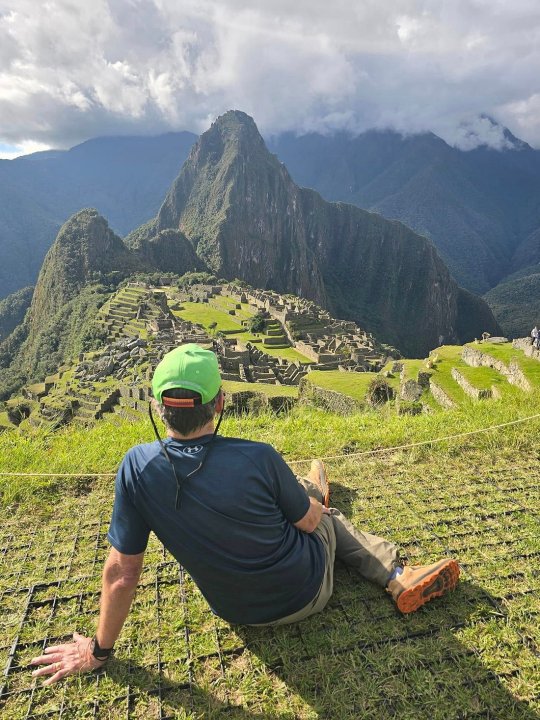
Stunning hike, and Henrry is the best!
This was the Royal Inca Trail one-day hike, starting at KM 104 and finishing at Machu Picchu.
Our guide was Henrry Chauca, and he is excellent. I was twice the age of the other six hikers, and therefore the slowest. Henrry made sure that I was always safe, kept encouraging me, told me to take my time. This is not an easy hike - lots of stairs - but at age 68 I made it! I am convinced that my guide made all the difference in the world. All day long we were "family" - and we were. Lots of stops for interesting explanations of the Inkan ruins or the stunning landscapes before our eyes. Henrry also gave us an interesting 2-3 hour tour of Machu Picchu Circuit 3. There is just so much to know here!
ITEP was super-helpful in arranging logistics. Our plans changed 4-5 times, and they displayed immense patience with me as we kept changing our minds. My wife's itinerary was different and she waited too long to book Machu Picchu entry, but ITEP pulled a rabbit out of the hat and found her a ticket at the last minute. (But maybe don't always count on that.) I can't say enough about how easy it is to work with ITEP - they always had a creative solution. All the correspondence is via WhatsApp. For our next trip to Cusco and MP, I will only use ITEP to book tours.
PS. The attached photo was Henrry's idea, and he took the photo on my phone. Really clever shot!
More info:
+51 970 506 205
#inkatrail#incatrail#machupicchu#trek#trekking#hike#hiking#trekkinglovers#hikers#adventure#travel#tour#1daytrek#shorttrek#1dayincatrail#incatrail1day
1 note
·
View note
Text
Experience the 2 Day Short Inca Trail with Alpaca Expeditions

Looking for an unforgettable adventure? The 2 day short Inca trail is the perfect option for those who want to experience the magic of Machu Picchu without committing to the full-length hike. Offered by Alpaca Expeditions, this journey begins with a scenic train ride from Ollantaytambo to Km 104, where your trek begins. The 2 day short Inca trail takes you through stunning landscapes, ancient ruins, and lush cloud forests. You’ll explore the fascinating ruins of Wiñay Wayna before arriving at the Sun Gate (Inti Punku) for your first glimpse of the majestic Machu Picchu. Spend the night in Aguas Calientes, and the next morning, enjoy a guided tour of the Lost City of the Incas. This shorter trek is ideal for those with limited time or for hikers looking for a less strenuous option. With Alpaca Expeditions, you’re ensured a well-organized, safe, and enriching experience, making your visit to Machu Picchu truly memorable. Don’t miss out on this incredible opportunity to hike the 2 day short Inca trail and witness one of the world’s most iconic archaeological sites.

#2 day inca trail with camping#2 day short inca trail#2 day vs 4 day inca trail#2 week peru itinerary with inca trail#3 day 2 night inca trail#3 day inca trail#3 day inca trail hike
0 notes
Text
Before I go on airplane mode during the 4 day/3 night hike along the Inca Trail to Machu Picchu, highlights of the last few days in Cusco with my friend:
Visiting the beautiful Cathedral of Cusco on Friday evening
Spending Saturday at the Museum of Pre-Colombian art, and then hiking up to visit the Inca ruins of Sacsayhuamán
Spending today visiting the enormous San Pedro Market - one of the biggest open air and indoor markets I’ve ever seen! It was filled with food and fruit stalls, people selling different herbs and wares, and open air sales of fruits, vegetables, and so many flowers. Later we went to a chocolate museum and a bean to bar chocolate making workshop where we roasted our own cacao beans, peeled them, and ground them into paste, which we used to make hot chocolate and chocolate bars
Eating delicious Peruvian food
It’s been amazing to get a little taste of this city. I’m excited that we’ll get to spend part of the day on the 24th here before we depart for Lima and then on to home.
We’re spending a good chunk of next week in the Andean mountains :) so I’ll check in when we get back. With pictures! I hope you all have a great week!
19 notes
·
View notes
Text
A 4-Day Journey Along the Lares Trek to Machu Picchu
In the heart of the Peruvian Andes lies an adventure waiting to be uncovered — the awe-inspiring Lares Trek to Machu Picchu 4 days. Our journey transcends the ordinary, offering a 4-day expedition that encapsulates the rich cultural tapestry, breathtaking landscapes, and the ancient allure of the Inca civilization.

Exploring the Andean Wonderland
The Lares Trek is a hidden gem, often overshadowed by the more popular Inca Trail. Yet, its allure lies in its exclusivity, providing a more intimate connection with the Andean landscape and local communities. Our Machu Picchu 4 day Hike journey delves into the heart of this unique trek, promising a blend of adventure and cultural immersion.
Traversing the Lares Trail: A 4-Day Itinerary
1. Cusco to Quishuarani
Our expedition kicks off in the historic city of Cusco, where we embark on a scenic drive to Quishuarani. Nestled amidst picturesque mountains, this quaint village sets the stage for our trek. Along the way, we encounter local communities, gaining insights into their customs and traditions.
2. Quishuarani to Cancha Cancha
The trail unfolds as we trek to Cancha Cancha, weaving through undulating landscapes and verdant valleys. This leg of the journey is punctuated by encounters with indigenous Quechua-speaking communities, providing a firsthand experience of Andean life.
3. Cancha Cancha to Ollantaytambo
As we ascend higher, the landscape transforms, offering panoramic views of majestic peaks. Our trek leads us to the archaeological wonder of Ollantaytambo, where ancient ruins whisper tales of the Inca civilization.
4. Ollantaytambo to Machu Picchu
The pinnacle of our journey is reached as we venture to Machu Picchu. Opting for the less-traveled path, we unveil the iconic citadel, savoring the moment without the crowds. Our 4-day odyssey concludes with the breathtaking sunrise over Machu Picchu, an unparalleled reward for our trekking endeavors.
Contact us for:-
Inca Trail private tour
Shortest hike to Machu Picchu
Salkantay Trek to Machu Picchu
Capturing Andean Wonders
To enhance the reader's experience, consider incorporating stunning visuals such as photos capturing the diverse landscapes, the vibrant local culture, and the awe-inspiring moments along the trek. Visual elements engage the audience and evoke a sense of wanderlust.
Conclusion
Our 4-day journey along the Lares Trek to Machu Picchu is more than a trek; it's an odyssey of cultural immersion, natural marvels, and historical revelations. As we traverse through the Andean wonders, we invite fellow adventurers to join us in unlocking the secrets of this hidden gem.
1 note
·
View note
Text
The Inca Trail - Parte Uno
Sam Travel picked 10 of us up from our hotel dark and early at 4:30 AM on Friday to begin our journey. We stopped in Ollantaytambo for a hearty breakfast before continuing on to Piskacucho or Kilometer 82 to begin our trek. There, our lovely porters gathered our belongings and we took off with only our small daypacks and our guides, Jhony and Junior.
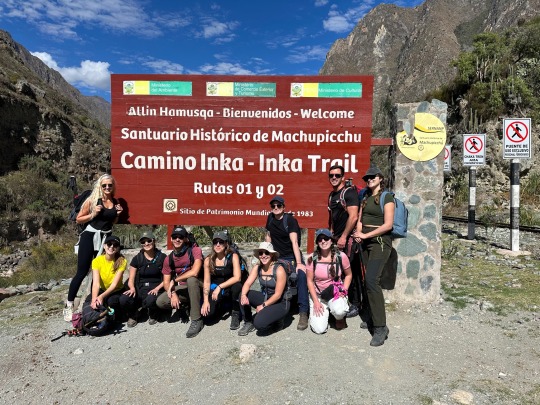
Besides the early wakeup, it was a pretty easy first day with 7.5 miles of undulating terrain. Along the way we got to observe a few Inca sites. We were all faster than anticipated and arrived at our lunch spot early which earned us a short siesta while the chef and porters set us up a fantastic 3-course lunch with salad, soup, and a buffet-style main course.
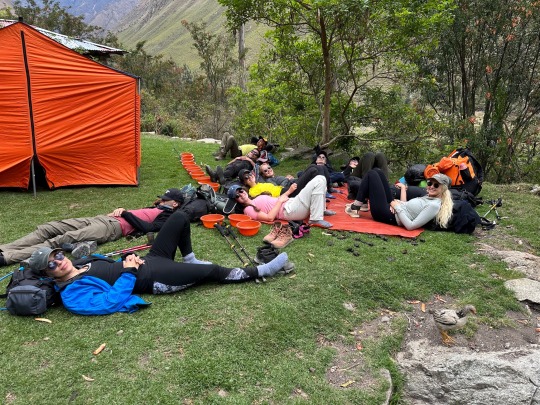
When we arrived at our beautiful campsite, our tents had already been set up in a line with mountain views surrounding. We changed into our comfy clothes and played with the multiple puppies that were running around the site. For dinner, we had a four course meal and then we ended the night playing the card game shithead.

We awoke around 4:30 AM to a knock on our tent from 3 porters dressed in orange suits offering us coca tea to drink as we got ready. Day 2 was the day of the climb to Dead Woman's Pass which required almost 3k ft of elevation gain to reach a height of 13,779 ft and around 10 miles of hiking.
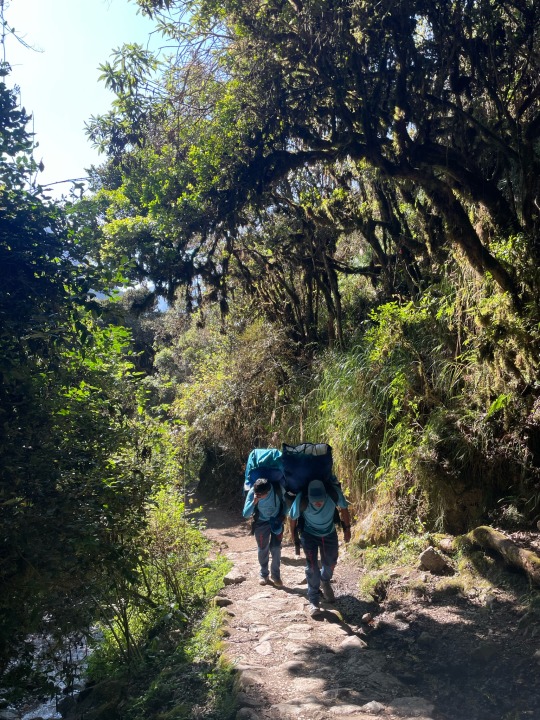
Instead of an elaborate trail lunch, the group opted for a 10:30 AM cheese and tea time so we were able to power through the trail and relax once we got to camp.

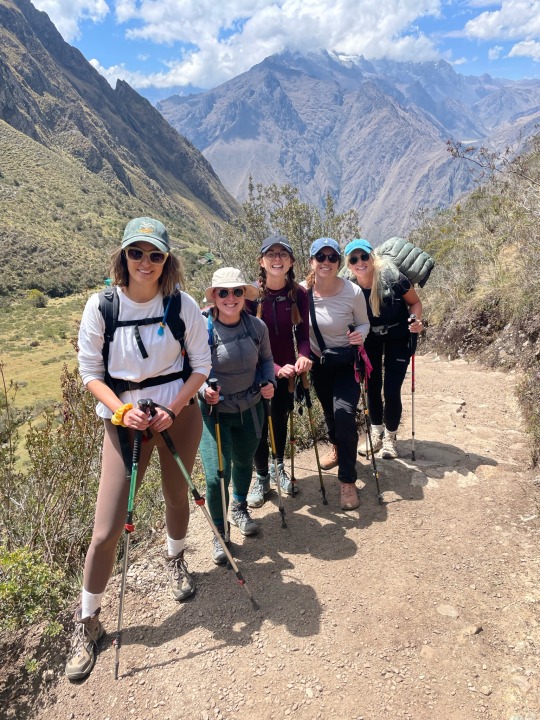
Bess and I lead the pack for a majority of the day as we powered up the seemingly never-ending steps. In the morning the trail was tree-lined, but as we got closer to the top, it became more exposed. The top of Dead Woman's Pass revealed expansive views of the Andes and sense of accomplishment for everyone - we had already completed the hardest part of the trail! It was (mostly) downhill from there.
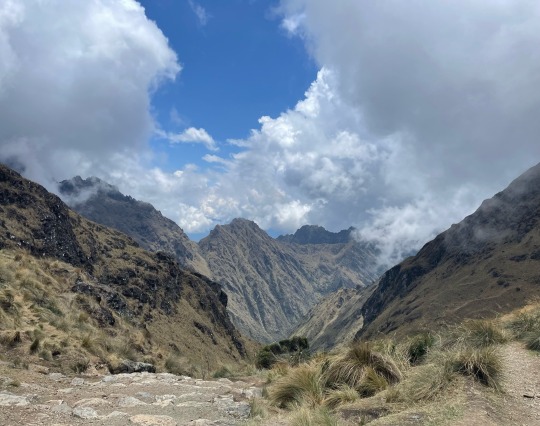

To keep ourselves going, Bess, Amelia, and I took turns singing whatever songs came to mind from artists ranging from The Beatles, to Brittney Spears to Disney.
When we got to camp, we rested before tea time where we were welcomed with a flaming turkey decorated with marshmallow feathers. Again, we played shithead and it only got more intense. We had another elaborate dinner and then I ended the night by reading Amelia, my tent-mate, a portion of my book "Circling Around the Sun". When Amelia fell asleep, I stopped reading and then got complaints from Bess and Meredith in the neighboring tent who wanted to know what happened next, so, I continued.
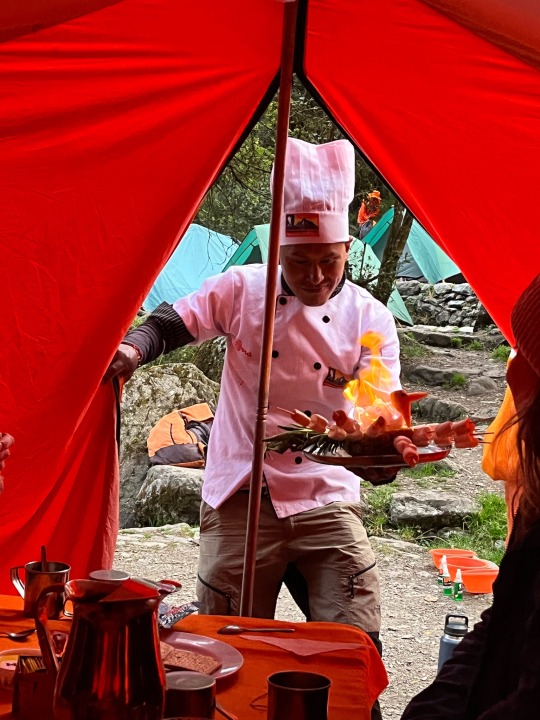
4 notes
·
View notes
Text
Here we go again!
It's nearly 8 years since Carmen, the Mad Malterer (MM) and I, Stern John (SJ) set out on our 8 month round the world backpacking trip and recorded our ups and downs in "Around the World in 80 Arguments" (www.tumblr.com/jsbwt). Since then we've revisited India, Sri Lanka, Australia and South Africa before Covid got in the way and put a stop to our travels and my meanderings. However, as you know, nothing stops MM when she's on a mission and she's been pestering me for some considerable time to set up a trip to backpack through South America as she's always wanted to visit Machu Picchu, or Michie Pichie as she insists on calling it.
As usual, she's got her own way so our back packs are packed and we set off tomorrow morning at 3.30am to catch a flight to Madrid from Heathrow. At Madrid, we'll catch a connecting flight to Lima in Peru which should arrive there around 19.00 local time, midnight UK time. It'll be a long day and I'm not sure that my extremely rudimentary spanish (4 weeks on Duolingo) will hold out when we arrive in Lima and have to find our way to our hotel.
This is going to be a fairly full-on trip. In fact I think we might need a holiday when we get back. After a couple of days recuperating in Lima we will fly up to Cusco (11,152ft) for 2 days to acclimatise to the altitude before getting up at 4.00am and undertaking a 10 hour Inca Trail trek to Machu Picchu. The next day we will have a 6am start to re-visit the Machu Picchu site at sunrise (another bloody sunrise!).
Having got that out of the way we'll travel to Puno (12,500ft) and visit Lake Titicaca before crossing into Bolivia and travelling to La Paz, the highest capital city in the world (12,000 ft). From there we'll fly to Sucre and then Potosi before getting ourselves to Uyuni where we'll do a 3 day, 4 wheel drive crossing of the Salar de Uyuni (the Bolivian Salt Flats) at 12,000ft too. From there we'll cross the border into Chile at Hito Cajon and head for San Pedro de Atacama where we can take the bus to Calama to catch our flight to Santiago. Whilst in Santiago we'll take a trip to Valparaiso before crossing into Argentina and down to San Carlos de Bariloche in Patagonia before flying up to Beunos Aires, where we intend to Tango!, and then home.
Having read that back, it sounds as though I have a plan. However, other than the internal flights everything else is "on the hoof". Plus, it's difficult to know what to take with you as the weather is so changeable. We need warm gear, cold gear, wet gear and proper leather hiking boots - not easy when all you've got is a backpack.
On top of all that is the disrupter that is MM!
What could possibly go wrong?
1 note
·
View note
Text
Everything You Need to Know About the Lares Trek to Machu Picchu in 2025
If you’re planning a once-in-a-lifetime trip to Peru in 2025, the Lares Trail to Machu Picchu should definitely be on your radar. This alternative trekking route offers a more authentic, less crowded experience than the famous Inca Trail, while still leading you to the awe-inspiring Machu Picchu. Whether you’re a seasoned trekker or a first-time adventurer, the Lares Trek offers a beautiful, culturally rich journey through the Andean mountains.
Here’s everything you need to know about the Lares Trail to Machu Picchu in 2025.
What is the Lares Trek to Machu Picchu?
The Lares Trail to Machu Picchu is a multi-day hike that takes you through stunning Andean landscapes, traditional Incan villages, and breathtaking mountain scenery, all leading to the iconic ruins of Machu Picchu. Unlike the more crowded Inca Trail, which is famous for its archaeological sites along the way, the Lares Trek focuses more on nature and cultural immersion.
You’ll be walking through valleys surrounded by snow-capped peaks, traversing alpine lakes, and passing through indigenous villages where time seems to have stood still. It’s an incredible way to witness the beauty of Peru’s highlands while connecting with local communities who have preserved their ancient traditions.
Why Choose the Lares Trail to Machu Picchu?
The Lares Trek is becoming increasingly popular for a variety of reasons. Here are some key factors that make it a top choice for travelers in 2025:
Less Crowded: One of the main advantages of the Lares Trail over the Inca Trail is that it’s far less crowded. While the Inca Trail requires a permit and is often fully booked months in advance, the Lares Trail offers a quieter, more serene trekking experience, allowing you to truly immerse yourself in nature and the local culture.
Cultural Immersion: Along the Lares Trail, you'll have the opportunity to interact with indigenous Quechua communities. These villages, such as Lares and Cuncani, provide a rare opportunity to see traditional Andean life up close. You’ll get to witness local artisans weaving textiles, herding llamas, and practicing ancient agricultural techniques.
Stunning Scenery: The Lares Trek offers some of the most spectacular landscapes in all of Peru. The route takes you through lush valleys, high-altitude lakes, and rugged mountain passes. If you love outdoor adventure, you’ll be treated to awe-inspiring views at every turn.
A Unique Experience: Unlike the Inca Trail, which is often busy with trekkers, the Lares Trail provides a more intimate and off-the-beaten-path experience. For those looking to escape the crowds and explore the heart of the Andes, this trek is an ideal option.
What to Expect on the Lares Trail Trek
The Lares Trek typically spans 3 to 4 days and covers approximately 33 to 40 kilometers (20-25 miles), depending on the route chosen. The trek reaches altitudes of up to 4,500 meters (14,764 feet) above sea level, so it’s important to prepare for the high-altitude environment. Here’s a general outline of what you can expect each day:
Day 1: Lares to Cuncani
You’ll begin your journey in the town of Lares, famous for its hot springs. After a relaxing soak, you’ll embark on a gradual ascent towards the village of Cuncani. Along the way, you’ll pass through beautiful valleys and see terraced farmland, as well as interact with the locals. You’ll camp overnight near the village.
Day 2: Cuncani to Ipsaycocha Lake
On the second day, you’ll hike up to the high-altitude Ipsaycocha Lake, where you can admire stunning mountain views. This day includes a challenging climb, but the rewards are immense – from the lake, you’ll have a panoramic view of the surrounding peaks. The day concludes with a descent to a campsite near the lake.
Day 3: Ipsaycocha to Ollantaytambo
The final day of the trek will take you down to the Sacred Valley, where you’ll catch the train to Ollantaytambo, the gateway to Machu Picchu. In Ollantaytambo, you’ll have the option to explore the famous Inca ruins before continuing your journey to Machu Picchu.
Altitude and Acclimatization
The Lares Trek reaches elevations above 4,500 meters, which can be challenging for some trekkers. It’s crucial to allow time for proper acclimatization before starting the trek. Many tours recommend spending a day or two in Cusco, which sits at 3,400 meters, before beginning the hike. This will give your body time to adjust to the thinner air.
To minimize the risk of altitude sickness, stay hydrated, avoid alcohol, and take it slow during the trek. If you have concerns about altitude, consult with a doctor before embarking on the trek.
Best Time to Trek the Lares Trail to Machu Picchu
The ideal time to trek the Lares Trail to Machu Picchu is during the dry season, which runs from May to September. During these months, the weather is generally clear, making for optimal trekking conditions. The rainy season from November to March should be avoided, as muddy and slippery trails can make the hike more challenging.
If you're planning your trek for 2025, it's best to book your permits and tours well in advance, especially if you're traveling during the peak months of June, July, and August.
What to Bring on the Lares Trek
Packing for the Lares Trek requires careful consideration of the weather, altitude, and duration of the hike. Here’s a list of essential items you’ll need:
Good Quality Hiking Boots: A sturdy pair of waterproof boots will be essential for traversing the rugged terrain.
Clothing Layers: The weather can change quickly in the mountains, so packing layers is key. Bring a moisture-wicking base layer, warm fleece or down jacket, and a waterproof jacket.
Sun Protection: Sunscreen, sunglasses, and a hat are a must, especially in high-altitude areas where the sun can be intense.
Water Bottle or Hydration System: Staying hydrated is important, so bring a refillable water bottle or hydration pack.
First-Aid Kit: Carry essentials such as pain relievers, blister pads, altitude sickness medication, and any personal medications.
Camera: The scenery along the Lares Trail is breathtaking, so don’t forget to bring a camera to capture the memories.
The Lares Trail to Machu Picchu offers a unique and unforgettable trekking experience for those looking to explore the stunning landscapes and rich culture of Peru. In 2025, this trek remains one of the most sought-after alternatives to the classic Inca Trail, offering solitude, spectacular views, and a deep connection to Andean culture.
Whether you’re an experienced hiker or a newcomer to trekking, the Lares Trail to Machu Picchu is a journey that will leave you with lifelong memories. Plan ahead, prepare for altitude, and get ready for the adventure of a lifetime!
0 notes